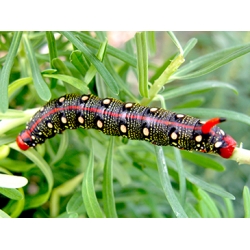- Current EGGS and LARVAE (54)
- EXOTIC BUTTERFLY PUPAE (11)
- MARKET STALL Everything a BARGAIN! (22)
- XXP super fast EXPRESS COURIER DELIVERY (2)
- CURRENT PUPAE - Chrysalides and cocoons (45)
- SILKWORM EGGS and Silkworms (6)
- SPRING and SUMMER EGGS and LARVAE Order now for supply in season (73)
- SPRING and SUMMER PUPAE You can order these NOW in advance (25)
- GIFT SUGGESTIONS (29)
- WINTER PUPAE for breeding in the following season (30)
- CAGES (10)
- PHASMIDS Leaf & Stick Insects, Mantids and more (2)
- SCHOOLS Recommended Livestock (14)
- SLEEVES for REARING LARVAE (7)
- PLASTIC REARING CONTAINERS (2)
- EQUIPMENT (29)
- MOTH TRAPS (7)
- NETTING (3)
- BOOKS (39)
- CHARTS (21)
- SPECIMENS for collectors (151)
- SILK Yarn, Fibres, Silkworm eggs (7)
Spurge Hawk Hyles euphorbiae
A very rare migrant to Britain. They have been found on sand dunes on the southern shores of England.
Fine, healthy pupae to emerge soon. In the emerging cage keep as described for the Pupae Nest on this website.
The moths breed at night and pairings are seldom seen. Provide potted foodplant on which the clusters of green eggs are laid. The larvae are black at first and they are gregarious. As they grow they separate and take on a multitude of amazingly bright and varied colours. The larvae will feed on most Spurges, including the summer weed Sun or Petty Spurge. The moths lay well on the tender shoots and Cypress Spurge Euphorbia cyparissias is a favourite. Larger larvae will feed the coarser Spurges, such as Caper Spurge and Wulfeni.
Pupae are formed on or beneath the surface of the ground. In warm conditions there may be multiple generations. Winter is spent as dormant pupae.
Only a few. They are for breeding in summer.
Dormant pupae are kept cool for the winter. Adults emerge in June/July.
Provide nectar flowers and potted Spurge plants for egg-laying. The best Spurges are Cypress Spurge (cyparissias), Wood Spurge, Sea Spurge, and the annual Sun or Petty Spurges are all suitable. Eggs are laid in clutches near the tips. The young larvae are black and cluster.
Soon they take on amazing spots and stripes of yellow, red, white and green. Some of the most colourful larvae in the world.










